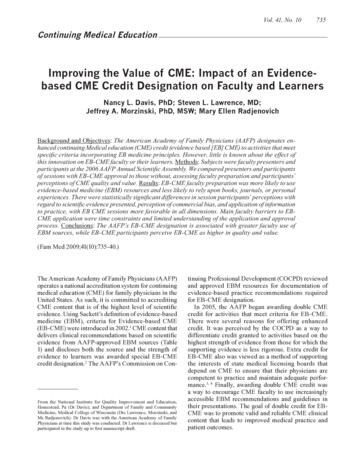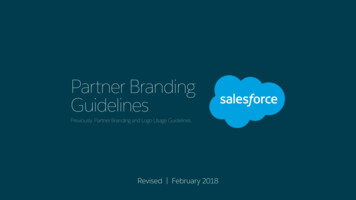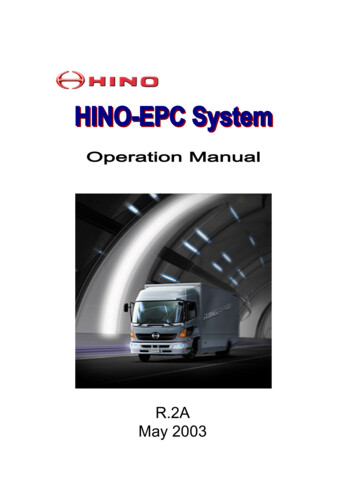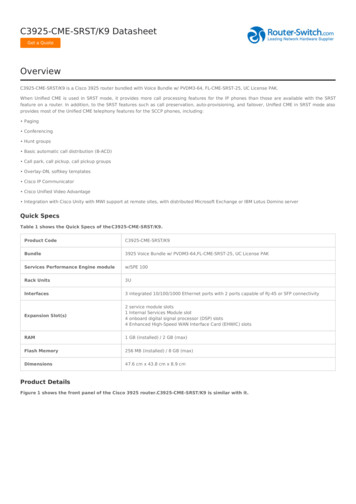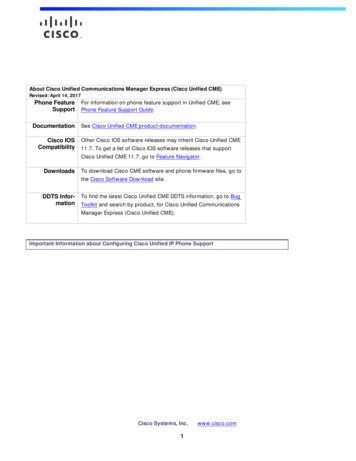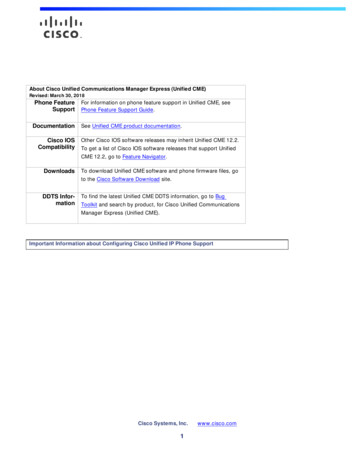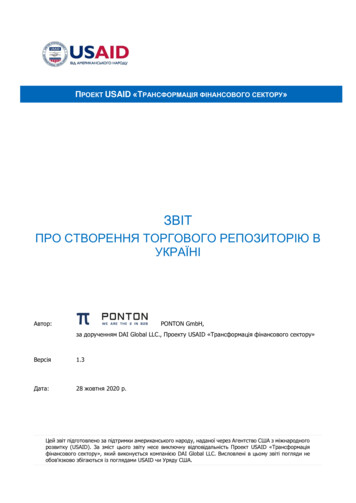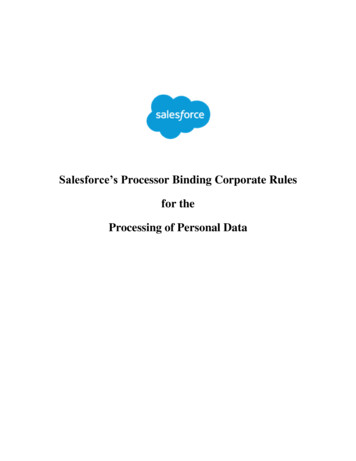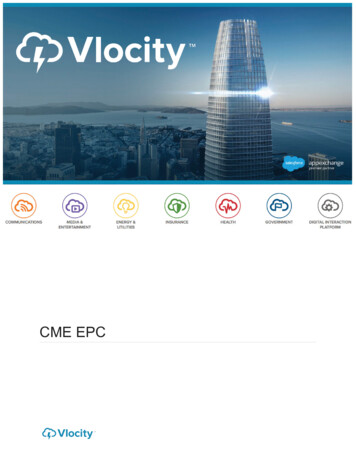
Transcription
CME EPC
Copyright 2021 Vlocity LLC, a Salesforce company. All rights reserved. Information in this document is subject to change withoutnotice. This documentation and the software, tools, templates and other material described in this document (“Vlocity Materials”) arefurnished exclusively under a subscription services agreement or nondisclosure agreement. The Vlocity Materials may be used orcopied only in accordance with the terms of those agreements. No part of the Vlocity Materials may be reproduced, stored in aretrieval system, or transmitted in any form or any means electronic or mechanical, including photocopying or recording for anypurpose other than the licensee’s personal use as set forth in the applicable agreement without the prior written permission of VlocityLLC. Vlocity is a trademark of Vlocity LLC, a Salesforce company, as are other names and marks. Other marks appearing herein maybe trademarks of their respective owners.
CME EPCTable of ContentsVlocity Enterprise Product Catalog (EPC) . 1Business Benefits . 2Solution Features . 3What's New in EPC . 5Fall '20 . 5Overview of New and Enhanced Features . 5Spring '20 . 8Overview of New and Enhanced Features . 8Winter '20 . 9Overview of New and Enhanced Features . 9Fall '19 . 11Overview of New and Enhanced Features . 11Summer'19 . 11Overview of New and Enhanced Features . 11Vlocity Support for TM Forum Frameworx . 14Vlocity EPC and the SID/TM Forum Model . 14Comparison of the Product Catalog Applications . 17Access to the Applications . 18See Also . 19Overview of Product Creation in Product Designer . 20What's Next . 22The Vlocity Product Designer . 22Open the Vlocity Product Designer . 23Navigate the Vlocity Product Designer . 23Manage Existing Object Types in Product Designer . 25Products with Attribute Assignments Inherited from Object Types Only . 26Products with Direct Attribute Assignments . 30Product Lifecycles . 32Product Selling Period Dates . 33Product Selling Period Definition . 34Create Picklists and Picklist Items in the Product Designer . 36What's Next . 40See Also . 40Attributes and Overrides . 40 2021 Vlocity LLC, a Salesforcecompany
CME EPCUses of Attributes . 40Overrides . 42Encrypted and Not Assetizable Attributes . 42Attributes vs. Fields . 43Attribute and Picklist Overrides for the Object Type and at the Product Level . 44Create Attribute Categories in the Product Designer . 46What's Next . 48See Also . 48Define Attributes in the Product Designer . 48What's Next . 51See Also . 51Object Types and Guidelines . 52Object Types Inheritance . 52Guidelines for Creating Object Types . 53See Also . 53Create Object Types and Layouts in the Product Designer . 53Create an Object Type . 55Define a Layout with Fields and Attributes . 57Applying Attributes to an Object . 59What's Next . 60See Also . 60Product Specifications and Characteristics for Product Designer . 61Types of Specifications . 62See Also . 62Create Product Specifications in the Product Designer . 62Results . 66What's Next . 66See Also . 66Create Offerings in the Product Designer . 66Results . 69What's Next . 69See Also . 69Configure Attribute Rules for Offerings in the Product Designer . 70Add Attachments in the Product Designer . 72Apply Context Rules to an Offering in the Product Designer . 74Offer Bundles, Cardinalities, and Relationships for Product Designer . 75Types of Product Line Items in a Bundle . 75Types of Cardinality in Bundles . 75Cardinality and Inheritance . 76See Also . 76Create Product Bundles in the Product Designer . 76Creating a Bundle . 77Results . 79Overriding the Cardinality of the Child Product Bundle . 80What's Next . 81See Also . 81 2021 Vlocity LLC, a Salesforcecompany
CME EPCOverride Product Attributes in Product Designer . 81Create Promotions and Offers for Product Bundles in the Product Designer . 82Offer Pricing for Product Designer . 89Pricing Components . 89Pricing Strategies for Product Bundles . 89Price Adjustments and Overrides . 90Pricing Adjustments Using Product Bundles . 90Recording Adjustments . 91Managing Simple Product Pricing . 91Product Cost . 91Offer-Based Adjustments and Overrides . 91Promotion-Based Adjustments and Overrides for Product Designer . 92Define Pricing for Offers in the Product Designer . 93Track Product Catalog Changes with Projects . 97Results . 98EPC Project Editing . 99Export a Product Report in Product Designer . 100Results . 101See Also . 102Configure the Product Attributes Report . 102Fix Duplicate and Empty Attributes . 105Product Definition with Vlocity Product Console . 106The Vlocity Product Console Interface .Using Facets .Navigating to the Vlocity Product Console .See Also .Product Lifecycles .Product Selling Period Dates .Product Selling Period Definition .Product References in the Shared Catalog .Product Selling Period Dates and Vlocity Cart .Upgrade to Product Selling Period Dates .Product Entities Overview .Product Object Types .Product Specifications .Vlocity Picklists .Product Attributes .Product Bundles .Types of Products in a Bundle .Create Products in Vlocity Product Console .Create a Price Book .Create New Product Attribute Categories .Create a Picklist . 2021 Vlocity LLC, a 119121123123130138139139140140
CME EPCCreate Attributes .Create an Object Type .Assign Attributes and Fields for an Object Type .Encrypted and Not Assetizable Attributes .Change the Product Attribute Display Sequence .Define the Layout for an Object Type .Create a Product Specification .142143144144147152155Product Definition with the Salesforce Interface . 156Add an Image to a Product .Associate a Product with a Price Book .Configure Attributes and Fields for an Object Type .What's Next .See Also .Add Product Child Items to a Product .Cardinality of Child Products in a Bundle .Minimum and Maximum .Code to Enforce Cardinality of ProductChildItems .Add Multiple Price Types for a Product .Update Products Designed in Aloha to Use the Product Console .Product Attributes .Create New Product Attribute Categories .Create a New Product Attribute .Set Up Product Attributes .Configuring the Attribute Values Sort Order in Picklists .Constrain Product Attributes Using a Format Mask .Configure Attribute Rules .Create a Product Attribute Template .Edit a Product Attribute Template .Fixing JSON Attributes .Guided Selling .Creating Guided Selling OmniScript Using CPQ APIs .Refreshing the Price Book Prior to Winter '18 .Exposing the Refresh Pricebook Button .Creating Catalogs and Catalog Relationships .Creating the Root Catalog .Creating Product Catalogs .Creating Catalog Relationships .Adding Products to a Catalog . 2021 Vlocity LLC, a 7187188
CME EPCVlocity Enterprise Product Catalog (EPC)Vlocity ‘s Enterprise Product Catalog (EPC) enables you to introduce and effectively manage a portfolio ofproducts that are relevant to customers, released at the most opportune time, and at a low cost. EPC helpsyou manage the end-to-end processes and product data relevant to the product development, productlaunch, and in-life product management activities of your organization.Vlocity EPC provides the core components necessary to centralize, configure, integrate, and maintain theproduct and service portfolio across the enterprise. Vlocity EPC, a centralized catalog, contains all of thecommercial and technical elements you use to define reusable product and service building blocks andresulting offersThe following diagram shows where EPC fits into the enterprise. The catalog consists of a commercial anda technical catalog.Vlocity Enterprise Product Catalog uses the IDX Workbench build tool to synchronize the productmanagement process and corresponding data into a single, automated, error-resilient stream throughreuse, shared resources and common tools: Through an enterprise scope, enables the definition of a single product catalog on one place, withmultiple subscribers and systems that consume the product catalog. Enables the creation of products once, making them available for reuse across the enterprise by differentsystems. Gives you a unified UI with common tools, enabling your teams to collaboratively and rapidly create,manage, and deliver product offers to the market. 2021 Vlocity LLC, a Salesforcecompany1
CME EPC Once implemented, eliminates data silos and includes both commercial and technical entities in a singlemodel. Allows you to import products from other systems. For example, if you want to move from a developmentto a production environment, you can use Vlocity DataPacks and document the import process. EPC can be leveraged by different types of users, such as product administrators, product managers,system administrators, and developers.Vlocity EPC gives your business an industry-leading, catalog-driven platform that revolutionizes the CPQand order management space by: Using a metadata-driven approach to accommodate the incarnations of a product as it travels fromtwinkle in the eyes of customer to physical implementation customer’s hands. Integrating with your end-to-end ecosystem using a product-service-resource (PSR) model to drive sales,configure-price-quote (Vlocity CPQ) and Vlocity Order-Management capabilities. Using an evolutionary approach to transform both front-office and back-office systems into a sharedcatalog-driven architecture.Business BenefitsCommunications, media, and energy companies gain significant benefits through the adoption of anenterprise-wide, centralized, product-management capability. An enterprise product-management solutionyields more highly competitive products with stronger profit margins and greater customer satisfaction.Vlocity Enterprise Product Catalog delivers these benefits, improving the bottom line through faster time-tomarket and lower cost-to-market, enabling innovation and improving quality across product lifecyclemanagement. 2021 Vlocity LLC, a Salesforcecompany2
CME EPCDecrease Time-to-Order for New Products and Offers: Deliver a unified catalog across CPQ, CLM andOM for all products & services to reduce sales cycle and order orchestration times.Accelerate Responsiveness to Changing Market Conditions: Centralize product catalog managementwithin an agile, cloud platform to improve responsiveness and flexibility for changing business needs.Improve Product Lifecycle Agility and Efficiency: Leverage next-generation catalog capabilities. Viewcustomer assets across all product or service stacks. Automate notifications to appropriate teams for orderfallouts or manual intervention requirements.Deliver a Cohesive and Consistent Catalog: Eliminate reliance on legacy systems and deliver a unifiedcatalog for centralized lifecycle product management.Time-to-MarketFaster time-to-market means: Reduced design, build, test and launch time for products through component reuse.A reduced volume of data required to assemble and establish new offerings in the architecture.A first-mover advantage.Simplified and accelerated new product and service introduction through improved clarity around what tooffer, which is critical in responding to competitors.Cost-to-MarketLower cost-to-market means: Reduced operational and delivery costs through fewer disparate data points to manage. Reduced complexity of business processes. Structured components that maximize compatibility with long-term reference architecture.InnovationEnabling innovation provides: Increased ability to support complex propositions due to simpler set-up from any channel. Rapid monetization of data moving among people and systems through simplified definition of a unifiedproduct. Improved customer satisfaction through better understanding of the product purchased. Ability to compete with and support web-application and cloud-based solutions.Solution FeaturesVlocity Enterprise Product Catalog product provides the core components necessary to centralize,configure, integrate, and maintain the product and service portfolio across the enterprise. Vlocity EnterpriseProduct Catalog brings together, into a single catalog, all of the commercial and technical elements thatdefine the reusable product and service building blocks and resulting offers.The Product Console user interface provides a single point-of-entry and single point-of-access to theproduct and service data, through which users can perform all the activities necessary to manage the full 2021 Vlocity LLC, a Salesforcecompany3
CME EPCcatalog of product offerings and underlying services, including the creation, modification, reuse, launch,maintenance, and retirement of products and services.Key features of Vlocity Product Console include: Collaboration environment for both business and IT users. Cross-function, role-based user definitions and security. Centralized Data Management for the product and service catalog: Componentized data model for offers, products, services, devices, pricing, target system rules, andprocesses. Simple and complex product and service structures. Definition of commercial and technical aspects of product and service components. Sharing of product components across different product and market categories. Cloning and modification of product structures or individual entities to enable rapid product modeling. Business and technical modeling of product offers and underlying component specifications. Highly configurable capability for defining rating attributes for charges and discounts, to supportattribute-based, tiered, threshold, and flat rating and discounting, variable across product lines. Channel-, market-, and customer-specific price lists to manage the reuse of products across targetmarkets through different offers. SID-compliant and SID-based XML available. 2021 Vlocity LLC, a Salesforcecompany4
CME EPCWhat's New in EPCThis section provides a summary of the new features and enhancements for Vlocity's Enterprise ProductCatalog. Check back frequently as this page is updated on a regular basis, in between releases.Fall '20Overview of New and Enhanced FeaturesThe Vlocity Enterprise Product Catalog (EPC) includes the following feature enhancements for Fall '20.Vlocity Product DesignerThe next generation Vlocity Product Designer provides a unified user experience and the agility to quicklylaunch products and services. In this release, Vlocity introduces several enhancements to the VlocityProduct Designer. Bundling Products — For improved usability, the Structure view of a product uses icons so that you canmore easily differentiate products and their relationships without having to open each to view the details.The Structure view also includes a legend of the icons and their meanings. Specification types (product, offers, service, and resource) Simple and complex product bundles Relationship types between products: Parent-child relationship Associated product specification Attribute Metadata — You can now set select attributes to be excluded from searches of the basketcache for the same bundled product to maximize the basket cache hits in Vlocity Digital Commercesolution. Use this for attributes that are specific to a customer. If enabled, the attribute is not part of theresponse cache when the Digital Commerce ConfigureOffer API is called. For example, you can set theIMEI or serial number attribute to be excluded from the cache. By default, this property is set to False.Use this property for attributes whose values are unique for each account. See Define Attributes in theProduct Designer. Reports (Beta) — To help with audits and product reviews, you can export a report of products with theirproperties and attributes from the product search page in Vlocity Product Designer. You can alsoconfigure the columns, or fields, used for the products and attributes.EPC ProjectsIn Vlocity Product Designer, you can use Projects to track all changes made to any object in your productcatalog. Changes tracked when using Vlocity Product Designer but not with the Vlocity Product Console. Inthis release, the Projects feature has these enhancements: You can select multiple changed items in a project and move them to another project or remove themfrom the current project. You can also track the action (such as Add, Change, and Delete) taken on the referenced project item. 2021 Vlocity LLC, a Salesforcecompany5
CME EPC The options for the Lif
Business Benefits. CME EPC


